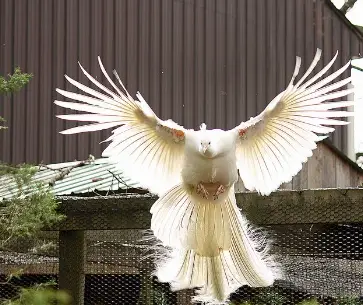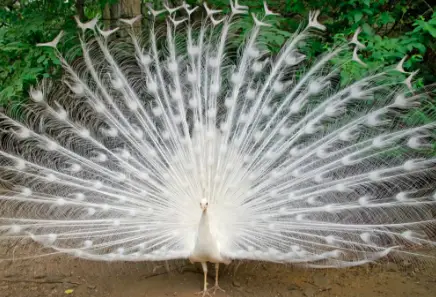White Peacocks Do Exist
Picture this: you’re wandering through an aviary or down forest path, and suddenly there it is. A silent apparition of elegance. That’s the white peacock: rare, ethereal, and unforgettable.
Whether you’re just starting your birding journey or you’ve been logging sightings since childhood, you’re about to gain insight into a rare bird indeed.

What Is a White Peacock, Really?
Despite its name, the "white peacock" isn’t a separate species. It’s the Indian Peafowl (Pavo cristatus), but with a twist—leucism, an inherited condition that involves a partial or total lack of feather pigment.
Fun fact: Unlike albinism (which affects the whole body and eye color), leucism leaves those familiar dark eyes intact.
Leucism occurs because pigment-producing cells fail to migrate properly during feather growth. The result? Plumage that looks dipped in primer paint but remains structurally identical to that of its colorful relatives.
A Splash of History: Humans and White Peacocks
Across cultures, the white peacock has been more than just a bird—it’s been a symbol. In India, it represents purity and spirituality. In medieval Europe, it adorned aristocratic gardens as a living sculpture.
Where You Might Encounter Them
You’re most likely to see white peacocks in aviaries, zoological collections, or private estates. Breeders deliberately select leucistic lines to preserve this striking look, since it would rarely survive in the wild where camouflage is key.
White Peacock Behavior: No Different, Just Dressed in White
Here’s the fun part: leucism doesn’t touch personality. White peacocks strut, fan, and call in the same theatrical ways as their blue-green kin. If you’ve ever watched a peacock’s tail unfurl like a fireworks finale, the white version simply adds a twist.
Care Considerations for Keepers
If you’re lucky enough to care for one, their needs mirror any Indian Peafowl:
- Space to roam and fan.
- Predator-safe enclosures, since their lack of camouflage makes them obvious targets.
- Protein-rich diets to fuel feather regrowth.
Curious about bird care? Our multiple guides on bird care are must-reads.
Lessons for Birders
The white peacock teaches us to look past color. Novices can train their eye on behavior and structure—crest, call, gait—rather than plumage alone. Experts can dive deeper into pigment genetics and selective breeding, refining how they log anomalies in their birding notebooks.
This is one bird with which you can probably skip the spotting scope if you're lucky enough to be in their vicinity.
For more, compare leucism with similar traits in understanding the difference between albinism vs leucism.
❓ White Peacock FAQs
Are white peacocks a separate species?
No. They’re Indian Peafowl (Pavo cristatus) with leucism, a genetic condition that reduces or prevents pigments in feathers while keeping the eyes dark.
What’s the difference between a white peacock and an albino peacock?
Albino birds lack melanin and usually have pink or red eyes. White peacocks are leucistic, which means they lack all pigment, not just melanin. This means their plumage is white but their eyes remain dark.
Can you see white peacocks in the wild?
Sighting a white peacock in the wild is beyond rare. Most are bred in captivity where their genetics can be safely preserved and passed down to offspring.
Do white peacocks behave differently than regular peafowl?
Nope. They fan, call, and strut just like their colorful relatives.
How much does a white peacock cost?
They’re specialty birds, often priced higher than blue peafowl. Cost depends on breeder and availability.
Is it ethical to breed white peacocks?
It depends. Ethical breeders focus on welfare—ample space, proper nutrition, and genetic diversity. Do your research before making a decision.
What do white peacocks symbolize?
Many cultures see them as emblems of purity, transformation, and mystical good fortune.
More on BirdingHub.com
- Check out our list of the best squirrel-proof feeders
- Take a look at the best spotting scopes at any budget
- Read up on all our articles sorted by bird appearance
